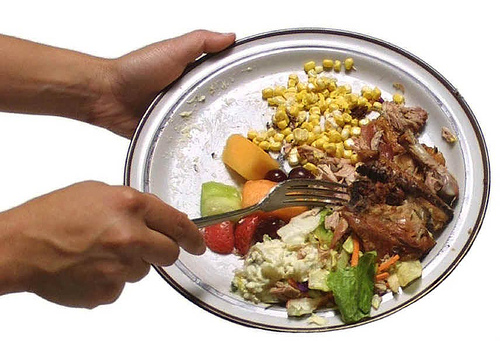Send your question to Umbra!
Q. Dear Umbra,
Do you have a reliable source/figure for the total amount of food wasted by Americans? I read somewhere that up to 40 percent of the food we buy may be thrown away. That means people spend an additional 66 percent on food products they don’t/can’t actually consume. Most of this “subsidy” goes to food processors, not to mention packaging, transporting, fertilizer, and, of course, agro-corps like Monsanto. Do you know if those figures are accurate?
Professor Ike
Wichita, Kan.
 Someone has too much food on their plate …Photo: jbloomA. Dearest Ike,
Someone has too much food on their plate …Photo: jbloomA. Dearest Ike,
It’s true that in the U.S. we waste an unappetizing amount of food (while somewhat ironically still adding to our waistlines). Estimates of how much food we toss vary, but according to Jonathan Bloom, author of American Wasteland: How America Throws Away Nearly Half of Its Food (and What We Can Do About It), we’re wasting around 40 percent of the total.
Or take this from an article in The Economist published in late 2009:
[T]he average American wastes 1,400 kilocalories a day. [Kilocalories is another word for what Americans generally just call “calories.”] That amounts to 150 trillion kilocalories a year for the country as a whole — about 40 percent of its food supply, up from 28 percent in 1974. Producing these wasted calories accounts for more than one-quarter of America’s consumption of freshwater, and also uses about 300 million barrels of oil a year. On top of that, a lot of methane (a far more potent greenhouse gas than carbon dioxide) emerges when all this food rots.
World food prices hit an all-time record high last month. According to analyst and author Lester Brown, “Soaring food prices are already a source of spreading hunger and political unrest, and it appears likely that they will climb further in the months ahead.” As the AFP notes, “Rising food prices have been cited among the driving forces behind recent popular revolts in north Africa, including the uprising in Egypt and the toppling of Tunisia’s long-time president Zine El Abidine Ben Ali.” In that light, our misuse of food seems even uglier than ever.
Despite the soaring global food prices, a recent USDA report recently showed that U.S. food costs are at an all-time low of 6.9 percent of household budgets. This is a lower percentage than almost any other country in the world. As American Wasteland‘s Bloom notes in his blog, “That cheapness has a real impact — we don’t tend to value that which is inexpensive. And by most any definition, something that’s 7 percent of our budget is cheap. And each individual item is only a fraction of that percentage, providing little economic incentive not to waste.”
Now, I’m not sure where you got that 66 percent statistic, Ike. But what I am sure of is that when we waste food, we waste other precious resources along with it. In a recent study conducted at the University of Texas, researchers determined our food-tossing equals the energy equivalent of 350 million barrels of oil per year. And that’s an admittedly low estimate, as the researchers used a 27 percent food waste rate to make calculations.
“Of course, as we here at Grist rant weekly, we pay for that kind of food in other ways — skyrocketing medical costs, environmental degradation, and the abuse of animals and farm workers. Now we can add the waste of precious fossil fuels to that list,” writes Bonnie Azab Powell.
From farm to fork, whether it’s plate waste or overproduction waste, it’s high time we reign in what we waste. “Waste not, want not,” goes the old saying. This is especially important as global oil prices fluctuate and drought and other unfavorable growing conditions for staple crops like wheat persist this year.
Consider pre-gleaning food at super markets that might otherwise end up going to the landfill. Yes, I mean freegan Dumpster diving! Composting is another great way to keep food from just being wasted and sent to the landfill, where the oxygen-free setting produces methane, a greenhouse gas 23 times stronger than carbon dioxide. Start composting your own food scraps and regenerate the soil instead. Check out my video on countertop composting and this Grist composting slideshow.
Waste-cutting expert Bloom says it’s also good to plan meals ahead of time, make a detailed shopping list, don’t go for impulse buys, and make sure you actually eat your leftovers. Also, the freezer is your friend and will keep things longer, as long as you remember to eat them.
Readers, what do you do to avoid wasting food? Don’t let your good ideas go to waste, share them in the comments below.
Unwastefully,
Umbra



